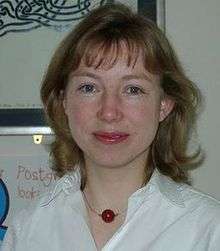Reidun Twarock
| Reidun Twarock | |
|---|---|
 | |
| Nationality | German |
| Fields | Mathematician, Biologist |
| Institutions | University of York |
| Alma mater | Technische Universität Clausthal |
| Known for | Mathematical Biology, Virology, Bioinformatics |
Reidun Twarock is a German-born mathematical biologist at the University of York. She is known for developing mathematical models of viruses based on higher-dimensional lattices.[1]
Education
Twarock originally studied mathematical physics at the universities of Cologne and Bath. During her PhD at Technische Universität Clausthal she experimented with quantum mechanical models confined to the surface of a sphere.
Research
In the early 2000s, while thinking about the Penrose tiling and different ways of dividing the surface of a sphere, she was able to come up upon a model describing the exceptional structure of papovaviridae, answering a question in virology that had been open for more than twenty years.[2] Almost all icosahedral viruses have the proteins on their capsids clustered in fives and sixes, with a structure permitting at most 12 clusters of five; but papovaviridae, including the cervical-cancer-causing HPV, have 72 clusters of five[3] This protein layout did not correspond to any known spherical polyhedron, leading to the difficulty of the question. Twarock's model of papovaviridae capsids resembles a Penrose Tiling wrapped around a sphere.
After this, Twarock entered virology, and began to rigorously link virus structure to fundamental ideas in geometry. It was well-understood that viruses have icosahedral shape and symmetry, but the only other thing that was said of them was that they sometimes they possessed planar translational symmetry, causing them to resemble goldberg polyhedra. The question of the exceptional nature of papovaviridae had been solved, but it was not a one-off - HK97 could not be considered a goldberg polyhedron either. Twarock's study of these viruses lead her to believe that there was much more insight into virology that could be gotten from mathematics. Mathematical virology had previously only studied how the surface of a virus was divided up into proteins, with models based on spherical polyhedra; Twarock hoped to go further than this, to illuminate three-dimensional protein structure and genome packaging.[4]
It was known that, using rotations, simple capsid patterns could be "generated" from a single shape by making copies of it and rotating them around certain axes. Twarock decided to consider adding an outward translation to this generating process, which created quite complex patterns of points in 3D space. These patterns turned out to perfectly predict the thickness and extrusions of proteins, as well as the structure of packaged genetic material, for many viruses including Nodaviridae.[5] These lattices can be thought of as three dimensional "pictures" of six-dimensional 6-demicubic honeycomb, which resembles the Tetrahedral-octahedral honeycomb. By changing the "angle" from which this picture is drawn, different lattices may be obtained that describe different viruses (including HK97 and papovaviridae). This is useful for viruses, who seek pattern-generating processes that allow them to compress information onto a smaller and more portable genome, which allows them to enter cells more easily. As a theory it also unifies human understanding of the structure of all known viruses.
Twarock is influenced by the study of Quasicrystals - higher-dimensional lattices are also used to generate quasicrystalline tilings. As with quasicrystals, her work has applications to the study of nanomaterials
See also
References
- ↑ Stewart, Ian. The mathematics of life. Basic Books, 2011.
- ↑ R. Twarock, A tiling approach to virus capsid assembly explaining a structural puzzle in virology, Journal of Theoretical Biology, Volume 226, Issue 4, 21 February 2004, Pages 477-482, ISSN 0022-5193
- ↑ Rayment, I., et al. "Polyoma virus capsid structure at 22.5 A resolution." Nature 295.5845 (1982): 110-115.
- ↑ West, Mark (30 September 2007). "A symmetry approach to viruses". Plus Maths. plus magazine. Retrieved 30 November 2014.
- ↑ Keef, Thomas, and Reidun Twarock. "Affine extensions of the icosahedral group with applications to the three-dimensional organisation of simple viruses." Journal of mathematical biology 59.3 (2009): 287-313.